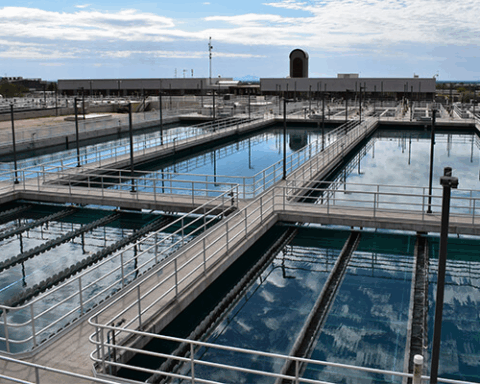The United States is experiencing a significant boost in domestic solar manufacturing, driven by recent federal policies designed to incentivize clean energy production and reduce dependence on foreign-made components. The Inflation Reduction Act (IRA), passed in August 2022, is the primary federal initiative behind a wave of investments in solar panel production and related technologies across the country.
Two years since the legislation’s passage, the results are starting to show, with new manufacturing facilities popping up across the country. There have been announcements for at least 32 new factories for a total of more than $18 billion in private investment, according to Jack Conness, an energy analyst with the California-based think tank Energy Innovation.
“There is an incentive to purchase and install U.S.-made solar panels,” Conness said in an interview with Government Market News. He runs the IRA + CHIPS Dashboard, which tracks announcements of new facilities that will benefit from tax credits passed through the Inflation Reduction Act or the CHIPS and Science Act, which passed in 2022 to boost the semiconductor manufacturing industry. “That’s always going to be part of the equation in terms of U.S. utilities understanding where to source their solar from.”
Tax Credits Creating Market Demand
The Inflation Reduction Act includes several provisions aimed at boosting domestic solar manufacturing, the most significant being the tax credit system. To incentivize the transition to renewable energy, the Internal Revenue Service pays solar power companies based on the amount of electricity produced and sold by utility-scale solar power installations. Alternately, the companies can choose to receive payment for a percentage of their upfront investment in building a solar power installation.
Whether using the production tax credit or the investment tax credit, companies that build solar power installations for the grid receive up to a 10% bonus payment if the panels or other components they install are manufactured in the United States. Coupled with a recent 50% tariff of solar panels built in China, the IRA is driving market forces where it makes sense for investors to build factories in the United States.
In addition to the market incentive created by made in America bonuses on new solar power installations, there is another tax credit within the Inflation Reduction Act that benefits manufacturers directly. Section 45X, known as the Advanced Manufacturing Production Credit, offers cash rewards to companies that produce clean energy technology in the U.S., and it applies to finished solar modules as well as solar trackers, wafers, inverters and solar-grade polysilicon.
New Manufacturing Hubs
One of the companies flocking to the U.S. is PV Hardware (PVH), a solar tracker manufacturer, that recently opened a factory in Houston. Emilio Garcia, COO of PVH USA, explained the decision in an interview with Government Market News: “There is a new opportunity with the IRA in the U.S., and we want to use it.”
The benefits go beyond the tax credits. With so many new utility-scale solar installations popping up — especially in Texas — being nearby is convenient and can lead to cost savings. “It’s better to produce locally for the for the U.S. market,” Garcia said. “We avoid any worries about the transportation. We buy all the material locally in the US, and we transport all the material from the factory.”
With $30 million invested in Houston, PVH will use the 50,000-square-foot facility to produce solar structures and trackers. The structures hold solar panels in place while the trackers are a component that integrates hardware and automated software to adjust the position of the panels as the sun moves across the horizon. As opposed to staying in a fixed position, the trackers increase the amount of energy the solar panels can capture from the sun’s rays.
Texas is one of the hubs receiving major investments on the manufacturing side, with a handful of facilities being built in Houston and Dallas. According to Conness’ dashboard, other solar manufacturing hubs are popping up in Georgia and South Carolina, in Midwestern states such as Michigan and Ohio, and out west in Colorado and New Mexico. The full solar supply chain, however, could soon span the entire country, as Conness points out that minerals and components that go into solar modules can also be sourced domestically.
One example, he said, can be found in a facility located in Georgia where solar modules are being built with polysilicon produced in Washington state. Those solar panels are then being shipped around the country to begin supplying power to the grid.
“I think that’s really like of the past year, one of the really cool big wins where we’re seeing each step of the supply chain,” Conness said.
The Effect of Tariffs
While incentives are driving domestic production, the U.S. government has also implemented 50% tariffs on Chinese solar products to further support American manufacturers. These tariffs, which went into effect earlier this year, have sparked debates within the industry. Some trade groups advocate for even broader tariffs, while others express concerns about potential impacts on project costs and the speed of transitioning to renewable energy.
Shortly after announcing the tariffs in May, the White House released a statement outlining actions taken to strengthen the U.S. supply chain and “protect manufacturers and workers from China’s unfair trade practices.” The measures include adjustments to tariff policies aimed at closing loopholes, new guidance meant to more easily determine eligibility for IRA tax credits, and increased funding for domestic research and development.
While the U.S. solar manufacturing base is growing dramatically, it remains to be seen whether tariffs slow down the adoption of clean energy, or if the U.S. is producing solar modules at high enough volume and competitive enough prices.
“We’re kind of on the fly trying to fill a new [supply chain] while we’re slowly weaning off an old one,” Conness said.
He likened the current position of the industry and U.S. government policy to a “gas and break” balance.
“We are starting to see those gaps being filled, as we put those tariffs in, as we try to create a new supply chain that isn’t exclusively Chinese solar panels.”












